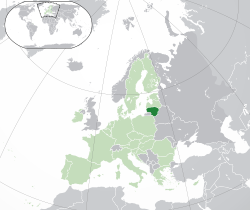
Back Литва Abkhazian Lithuania ACE Литуание ADY Litaue Afrikaans Litauen ALS ሊትዌኒያ Amharic Lithuania AMI Lituania AN Liþþuania ANG लिथुआनिया ANP
Republic of Lithuania Lietuvos Respublika (Lithuanian) | |
|---|---|
| Anthem: Tautiška giesmė National Hymn | |
 Location of Lithuania (dark green) – on the European continent (green & dark grey) | |
| Capital and largest city | Vilnius 54°41′N 25°19′E / 54.683°N 25.317°E |
| Official languages | Lithuanian |
| Other languages | |
| Ethnic groups (2015[1]) |
|
| Demonym(s) | Lithuanian |
| Government | Unitary semi-presidential republic[2][3][4][5] |
| Gitanas Nausėda | |
| Ingrida Šimonytė | |
| Viktorija Čmilytė-Nielsen | |
| Legislature | Seimas |
| Independence from Russia / Germany (1918) | |
| 9 March 1009 | |
• Coronation of Mindaugas | 6 July 1253 |
| 2 February 1386 | |
• Polish–Lithuanian Commonwealth created | 1 July 1569 |
| 24 October 1795 | |
| 16 February 1918 | |
| 15 June 1940 | |
| 22 June 1941 | |
• Liberation from the Nazi occupation | July 1944 |
| 11 March 1990 | |
• Independence recognized by the Soviet Union | 6 September 1991 |
• Admitted to the United Nations | 17 September 1991 |
• Joined the European Union | 1 May 2004 |
| Area | |
• Total | 65,300 km2 (25,200 sq mi) (121st) |
• Water (%) | 1.35 |
| Population | |
• 2020 estimate | |
• Density | 43/km2 (111.4/sq mi) (173rd) |
| GDP (PPP) | 2020 estimate |
• Total | $107 billion[7] (83rd) |
• Per capita | $38,751[7] (38th) |
| GDP (nominal) | 2020 estimate |
• Total | $56 billion[7] (80th) |
• Per capita | $20,355[7] (42nd) |
| Gini (2018) | medium |
| HDI (2018) | very high · 34th |
| Currency | Euro (€) (EUR) |
| Time zone | UTC+2 (EET) |
• Summer (DST) | UTC+3 (EEST) |
| Date format | yyyy-mm-dd (CE) |
| Driving side | right |
| Calling code | +370 |
| ISO 3166 code | LT |
| Internet TLD | .lta |
| |
Lithuania is a country in Europe. It borders Latvia to the north, Belarus to the southeast, Poland to the south and Russia to the southwest. It is one of the Baltic states. The country's area is 65,300 km² and there are about 2.8 million people who live in Lithuania. The national language is the Lithuanian language, which is spoken by around 3 million people. Vilnius is the capital and largest city. Lithuania is a member of the European Union, NATO, and several other organizations.[10]
The colors of the Lithuanian flag are yellow (at the top), for the sun, green (in the middle), for the fields, and red (at the bottom), for the blood of Lithuanians fighting for its independence.
- ↑ "Lietuvos gyventojų tautinė sudėtis 2014–2015 m." Alkas.lt. 16 December 2015. Retrieved 6 October 2017.
- ↑ Kulikauskienė, Lina (2002). Lietuvos Respublikos Konstitucija [The Constitution of the Republic of Lithuania] (in Lithuanian). Native History, CD. ISBN 9986-9216-7-8.
- ↑ Veser, Ernst (23 September 1997). "Semi-Presidentialism-Duverger's Concept—A New Political System Model" (PDF) (in English and Chinese). Department of Education, School of Education, University of Cologne: 39–60. Archived from the original (PDF) on 24 April 2021. Retrieved 23 August 2017.
Duhamel has developed the approach further: He stresses that the French construction does not correspond to either parliamentary or the presidential form of government, and then develops the distinction of 'système politique' and 'régime constitutionnel'. While the former comprises the exercise of power that results from the dominant institutional practice, the latter is the totality of the rules for the dominant institutional practice of the power. In this way, France appears as 'presidentialist system' endowed with a 'semi-presidential regime' (1983: 587). By this standard he recognizes Duverger's pléiade as semi-presidential regimes, as well as Poland, Romania, Bulgaria and Lithuania (1993: 87).
{{cite journal}}: Cite journal requires|journal=(help) - ↑ Shugart, Matthew Søberg (September 2005). "Semi-Presidential Systems: Dual Executive and Mixed Authority Patterns" (PDF). Graduate School of International Relations and Pacific Studies. United States: University of California, San Diego. Archived from the original (PDF) on 19 August 2008. Retrieved 23 August 2017.
- ↑ Shugart, Matthew Søberg (December 2005). "Semi-Presidential Systems: Dual Executive And Mixed Authority Patterns". French Politics. 3 (3). Palgrave Macmillan Journals: 323–351. doi:10.1057/palgrave.fp.8200087.
A pattern similar to the French case of compatible majorities alternating with periods of cohabitation emerged in Lithuania, where Talat-Kelpsa (2001) notes that the ability of the Lithuanian president to influence government formation and policy declined abruptly when he lost the sympathetic majority in parliament.
- ↑ "Pradžia – Oficialiosios statistikos portalas". osp.stat.gov.lt.
- ↑ 7.0 7.1 7.2 7.3 "Lithuania". International Monetary Fund.
- ↑ "Gini coefficient of equivalised disposable income – EU-SILC survey". ec.europa.eu. Eurostat. Retrieved 12 September 2019.
- ↑ "2017 Human Development Report". United Nations Development Programme. 2015. Retrieved 24 March 2017.
- ↑ "Lithuania - The World Factbook". www.cia.gov. Retrieved 2021-04-17.
© MMXXIII Rich X Search. We shall prevail. All rights reserved. Rich X Search

